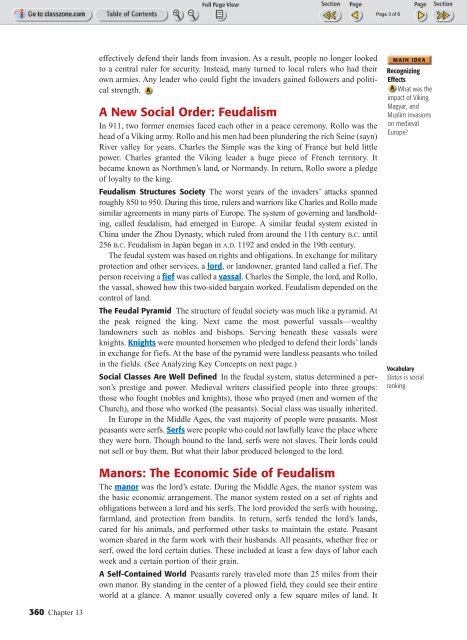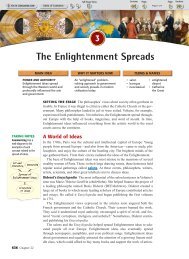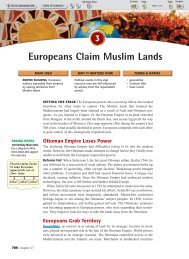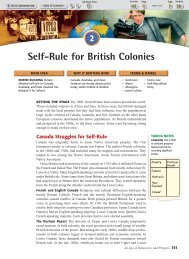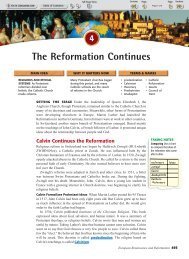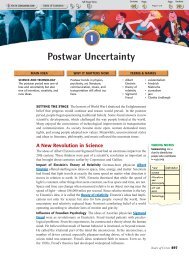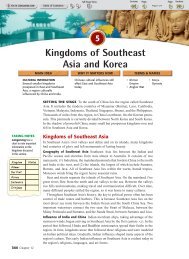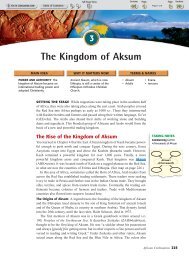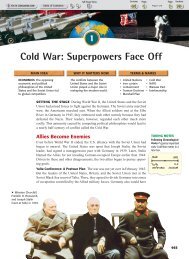Feudalism in Europe - Euro-webonline.com
Feudalism in Europe - Euro-webonline.com
Feudalism in Europe - Euro-webonline.com
- No tags were found...
Create successful ePaper yourself
Turn your PDF publications into a flip-book with our unique Google optimized e-Paper software.
effectively defend their lands from <strong>in</strong>vasion. As a result, people no longer lookedto a central ruler for security. Instead, many turned to local rulers who had theirown armies. Any leader who could fight the <strong>in</strong>vaders ga<strong>in</strong>ed followers and politicalstrength.A New Social Order: <strong>Feudalism</strong>In 911, two former enemies faced each other <strong>in</strong> a peace ceremony. Rollo was thehead of a Vik<strong>in</strong>g army. Rollo and his men had been plunder<strong>in</strong>g the rich Se<strong>in</strong>e (sayn)River valley for years. Charles the Simple was the k<strong>in</strong>g of France but held littlepower. Charles granted the Vik<strong>in</strong>g leader a huge piece of French territory. Itbecame known as Northmen’s land, or Normandy. In return, Rollo swore a pledgeof loyalty to the k<strong>in</strong>g.<strong>Feudalism</strong> Structures Society The worst years of the <strong>in</strong>vaders’ attacks spannedroughly 850 to 950. Dur<strong>in</strong>g this time, rulers and warriors like Charles and Rollo madesimilar agreements <strong>in</strong> many parts of <strong><strong>Euro</strong>pe</strong>. The system of govern<strong>in</strong>g and landhold<strong>in</strong>g,called feudalism, had emerged <strong>in</strong> <strong><strong>Euro</strong>pe</strong>. A similar feudal system existed <strong>in</strong>Ch<strong>in</strong>a under the Zhou Dynasty, which ruled from around the 11th century B.C. until256 B.C.<strong>Feudalism</strong> <strong>in</strong> Japan began <strong>in</strong> A.D. 1192 and ended <strong>in</strong> the 19th century.The feudal system was based on rights and obligations. In exchange for militaryprotection and other services, a lord, or landowner, granted land called a fief. Theperson receiv<strong>in</strong>g a fief was called a vassal. Charles the Simple, the lord, and Rollo,the vassal, showed how this two-sided barga<strong>in</strong> worked. <strong>Feudalism</strong> depended on thecontrol of land.The Feudal Pyramid The structure of feudal society was much like a pyramid. Atthe peak reigned the k<strong>in</strong>g. Next came the most powerful vassals—wealthylandowners such as nobles and bishops. Serv<strong>in</strong>g beneath these vassals wereknights. Knights were mounted horsemen who pledged to defend their lords’ lands<strong>in</strong> exchange for fiefs. At the base of the pyramid were landless peasants who toiled<strong>in</strong> the fields. (See Analyz<strong>in</strong>g Key Concepts on next page.)Social Classes Are Well Def<strong>in</strong>ed In the feudal system, status determ<strong>in</strong>ed a person’sprestige and power. Medieval writers classified people <strong>in</strong>to three groups:those who fought (nobles and knights), those who prayed (men and women of theChurch), and those who worked (the peasants). Social class was usually <strong>in</strong>herited.In <strong><strong>Euro</strong>pe</strong> <strong>in</strong> the Middle Ages, the vast majority of people were peasants. Mostpeasants were serfs. Serfs were people who could not lawfully leave the place wherethey were born. Though bound to the land, serfs were not slaves. Their lords couldnot sell or buy them. But what their labor produced belonged to the lord.Recogniz<strong>in</strong>gEffectsWhat was theimpact of Vik<strong>in</strong>g,Magyar, andMuslim <strong>in</strong>vasionson medieval<strong><strong>Euro</strong>pe</strong>?VocabularyStatus is socialrank<strong>in</strong>g.Manors: The Economic Side of <strong>Feudalism</strong>The manor was the lord’s estate. Dur<strong>in</strong>g the Middle Ages, the manor system wasthe basic economic arrangement. The manor system rested on a set of rights andobligations between a lord and his serfs. The lord provided the serfs with hous<strong>in</strong>g,farmland, and protection from bandits. In return, serfs tended the lord’s lands,cared for his animals, and performed other tasks to ma<strong>in</strong>ta<strong>in</strong> the estate. Peasantwomen shared <strong>in</strong> the farm work with their husbands. All peasants, whether free orserf, owed the lord certa<strong>in</strong> duties. These <strong>in</strong>cluded at least a few days of labor eachweek and a certa<strong>in</strong> portion of their gra<strong>in</strong>.A Self-Conta<strong>in</strong>ed World Peasants rarely traveled more than 25 miles from theirown manor. By stand<strong>in</strong>g <strong>in</strong> the center of a plowed field, they could see their entireworld at a glance. A manor usually covered only a few square miles of land. It360 Chapter 13


